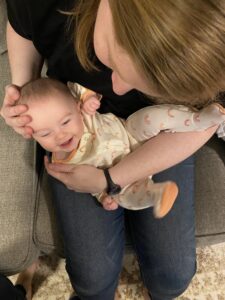By Rebecca Rudisill, PT, DPT, Pediatric Certified Specialist
What is torticollis?
Torticollis is a disorder, commonly seen in infants, in which tight neck muscles cause the head to turn and/or rotate to the side. The most commonly affected muscle is the sternocleidomastoid (or SCM for short) – a large muscle that runs from behind the ear to the breast bone and collar bone. The SCM causes the head to tilt to the same side and to rotate to the opposite side. Additionally, the tightness of the SCM can cause a cascade of tightness throughout the entire body. The incidence of torticollis has greatly increased over the past 30 years due to the Back to Sleep (now Safe to Sleep) program. Now that infants are spending more time on their back, they are not naturally turning their heads to clear their airway, which stretches out the neck. Back to Sleep is extremely important for infant safety and Sudden Infant Death Syndrome (SIDS) prevention, but torticollis is one possible outcome. The good news is that with early identification and treatment, torticollis can be fully resolved!
How do I know if my baby has torticollis?
Look back through your phone at pictures of your baby. Do they tilt their head the same way in every picture? This is a major indication that something is not right. Another indication is if your baby only looks in one direction and fusses if you turn their head the other way. If you notice your baby is developing a flat spot on their skull, their eyes or face look asymmetrical, or if they have rubbed off all the hair in a spot on one side of their head, they may have torticollis as well. If you notice a lump or bump on your baby’s neck, bring it to your doctor’s attention. This lump is likely a band of tight muscle tissue called fibromatosis colli or a pseudo tumor. It is a sign that your baby has torticollis.
Should I be looking for anything else?
Plagiocephaly, a fancy clinical word for a flattening of the skull on one side, is a condition commonly seen with torticollis. You may see flattening of the back of the head on one side, one ear pushed forward, a smaller eye or cheek on one side, or a shift in jaw alignment. When caught and addressed early in life, plagiocephaly is correctable with conservative treatment in physical therapy. If it is not caught early, babies may need to wear a helmet to correct their head shape. Helmets are very lightweight and usually do not bother babies at all. Treatment of plagiocephaly, whether conservative or more involved, is highly recommended to help your baby develop a round head shape. A round head is necessary for the appropriate fit of glasses, bike helmets, and sports helmets.
I think my baby has torticollis. Now what?
If you think your baby might have torticollis and/or plagiocephaly, ask your pediatrician to refer you to physical therapy. Sooner is better! Treatment is shorter and more likely to result in complete resolution of symptoms when therapy is started earlier. Beginning physical therapy before 3 months is best, but it is never too late to make a difference.
A physical therapist will assess your baby from head to toe, come up with a comprehensive treatment plan, and give you exercises to work on at home. Treatment for torticollis may include:
 Stretching of the tight muscles in the neck and trunk
Stretching of the tight muscles in the neck and trunk- Increasing active movement in the neck
- Strengthening the neck and trunk on both sides
- Visually tracking faces and toys in all directions
- Development of symmetrical, age appropriate gross motor skills
- Environmental changes to promote rotation to the opposite side
- Parent and/or caregiver education
- Aquatic therapy for children 1 year and older
Parent participation and completion of a home exercise program is a very important component of physical therapy treatment for torticollis. Your therapist will give you a combination of stretches, strengthening exercises, and developmental play to complete at home with your child. Regular completion of these exercises will stretch and strengthen your baby’s muscles helping the torticollis resolve.
For more information or to schedule an appointment with one of our therapists, please visit our website or contact Woman’s Center for Wellness at 225-924-8450.

